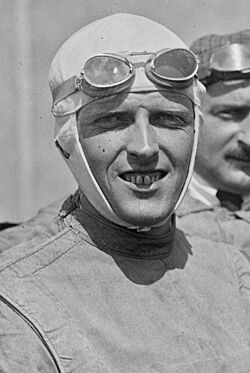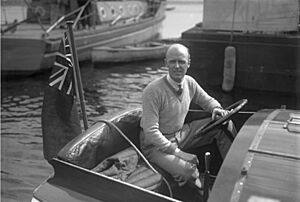Henry Segrave facts for kids
Quick facts for kids
Sir Henry Segrave
|
|
|---|---|

Segrave at the Grand Prix Sunbeams 1921, 1922 TT
|
|
| Born |
Henry O'Neal de Hane Segrave
22 September 1896 Baltimore, Maryland, United States
|
| Died | 13 June 1930 (aged 33) Windermere, Westmorland, England
|
| Cause of death | crash during water speed record attempt |
| Education | Bilton Grange then Eton College |
| Occupation | Speed record holder |
Sir Henry Segrave (born September 22, 1896 – died June 13, 1930) was a brave British driver and pilot. He was famous for setting amazing speed records on both land and water. Henry Segrave was the first person ever to hold both these world records at the same time. He was also the first to drive a car faster than 200 miles per hour (320 km/h)!
Sadly, he died in an accident in 1930. This happened just after he set a new world water speed record. It took place on Windermere lake in England's beautiful Lake District. The Segrave Trophy was created to remember his incredible life and achievements.
Contents
Henry Segrave's Early Life
Henry Segrave was born on September 22, 1896, in Baltimore, Maryland, in the United States. His mother was American, and his father was Irish. He grew up in Ireland and later went to Eton College in England. He spent time at a house called 'Belle Isle' and learned to drive a houseboat there.
Serving in World War I
When World War I began, Henry Segrave joined the army. He trained quickly at Sandhurst and became an officer in November 1914. He joined the Royal Warwickshire Regiment and was known for being very brave. His soldiers called the 18-year-old officer 'The Lion's Cub'.
He was injured twice in battle. After recovering, he joined the Royal Flying Corps to fly fighter planes. In May 1916, he shot down a German plane. But in July, his plane was hit by anti-aircraft fire over the Battle of the Somme. He crashed and badly broke his ankle. This injury meant he could no longer fly in combat. He even joked that he was "the world’s worst pilot" because he often had messy landings.
Later, Henry Segrave helped with a new invention called the "Aerial Target." This was the first unmanned aircraft, or drone, to fly under control. It was tested in March 1917. He married actress Doris Stocker in October 1917. After the war, he left the Royal Air Force because of his injuries.
Exciting Motor Sports Career

After the war, car racing was just starting to become popular. British car makers began building faster and more reliable vehicles. Henry Segrave quickly became a champion driver.
In 1921, he won the first long-distance car race held in Britain. This "200-mile race" took place at Brooklands in Surrey. Segrave won in a Talbot-Darracq car. That same year, he raced in his first French Grand Prix.
In 1923, he made history by winning the French Grand Prix in a Sunbeam. This made him the first Briton to win a Grand Prix race in a British car! He also won the San Sebastian Grand Prix in Spain in 1924. After another win in France, he stopped racing cars to focus on breaking speed records.
Breaking Speed Records
Land Speed Records

On March 16, 1926, Henry Segrave set his first land speed record. He drove his "Ladybird" Sunbeam Tiger car at 152.33 miles per hour (245.15 km/h) on Ainsdale beach in England. A month later, another driver broke this record.
But Segrave was determined! On March 29, 1927, he became the first person to drive over 200 miles per hour (320 km/h). He set a new record of 203.79 miles per hour (327.97 km/h) at the Daytona Beach Road Course in Florida, USA. He used a powerful car called the "1000 HP Sunbeam," also known as "Mystery" or "the Slug."
His final land speed record was set on March 11, 1929, again at Daytona Beach. He drove a brand-new car called the Golden Arrow. With this amazing car, he reached a speed of 231.45 miles per hour (372.48 km/h).
Henry Segrave never tried to break another land speed record after this. He saw a terrible accident where American driver Lee Bible died trying to set a new record. The Golden Arrow was never used again and has only 18.74 miles (30.16 km) on its clock. You can see it, along with his other record-breaking cars, at the National Motor Museum, Beaulieu.
In March 2016, on the 90th anniversary of his first record, Henry Segrave's original Sunbeam racing car returned to Ainsdale beach. It was driven there again, just like he did!
Water Speed Records
In 1928, Henry Segrave had a special boat built called Miss England I. He wanted to win the Harmsworth Trophy from American racer Gar Wood. Wood was famous for his powerful "Miss America" speedboats. He was the first person to go over 100 mph (87 kn; 160 km/h) on water.
Miss England I used a single Napier Lion engine. Segrave believed its advanced, lightweight design would make it fast. Other boat designers, including Gar Wood, thought the boat looked too fragile. But Wood was a good sport and even offered Segrave advice on propeller and rudder design.
After setting his land speed record in 1929, Segrave went to Miami for his speedboat race against Gar Wood. Segrave won, which was Wood's first defeat in nine years! When Segrave returned to Britain, he was knighted for all his amazing achievements.
A Tragic End
On Friday, June 13, 1930, just a few months after becoming a knight, Henry Segrave drove Miss England II. He set a new water speed record of 98.76 mph (85.82 kn; 158.94 km/h) on Windermere lake. But on his third run, the boat flipped over at full speed.
The chief engineer, Victor Halliwell, sadly died in the crash. Mechanic Michael "Jack" Willcocks survived with a broken arm. Segrave was pulled from the water unconscious. He briefly woke up and asked about his crew. After being told he had broken the record, he died from severe internal injuries.
A large floating branch was found near the crash site. However, no one knows for sure what caused the accident. Some people thought the boat's design might have been too light.
Later, another driver named Kaye Don broke two more world water speed records in Miss England II.
Designing Aircraft
In the late 1920s, Henry Segrave became interested in flying again. He designed an aircraft for luxury touring. The first version was a wooden plane called the Saro Segrave Meteor. It flew for the first time on May 28, 1930. But its development was delayed because Segrave died a month later. Only three metal versions of the Blackburn Segrave were built.
Henry Segrave's Legacy
In 1930, the Segrave Trophy was created to honor Henry Segrave. This award is given to British people who show outstanding achievements in transport on land, sea, or air. The Royal Automobile Club gives out this special trophy.
Famous winners include Malcolm Campbell (1932), Stirling Moss (1957), Richard Noble (1983), Lewis Hamilton (2007), and John Surtees (2013).
Images for kids






